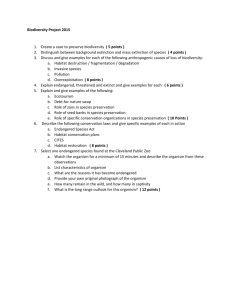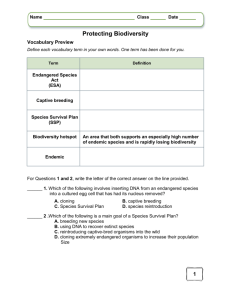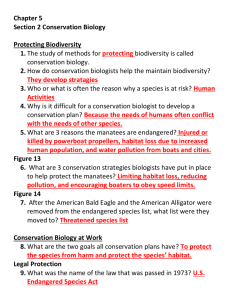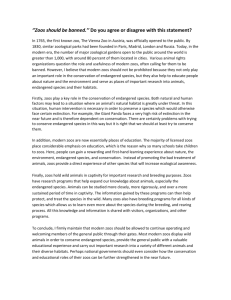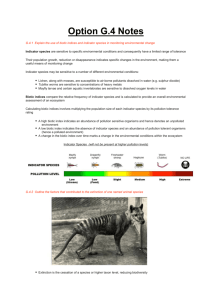The Future of Biodiversity 10.3 Pages 252
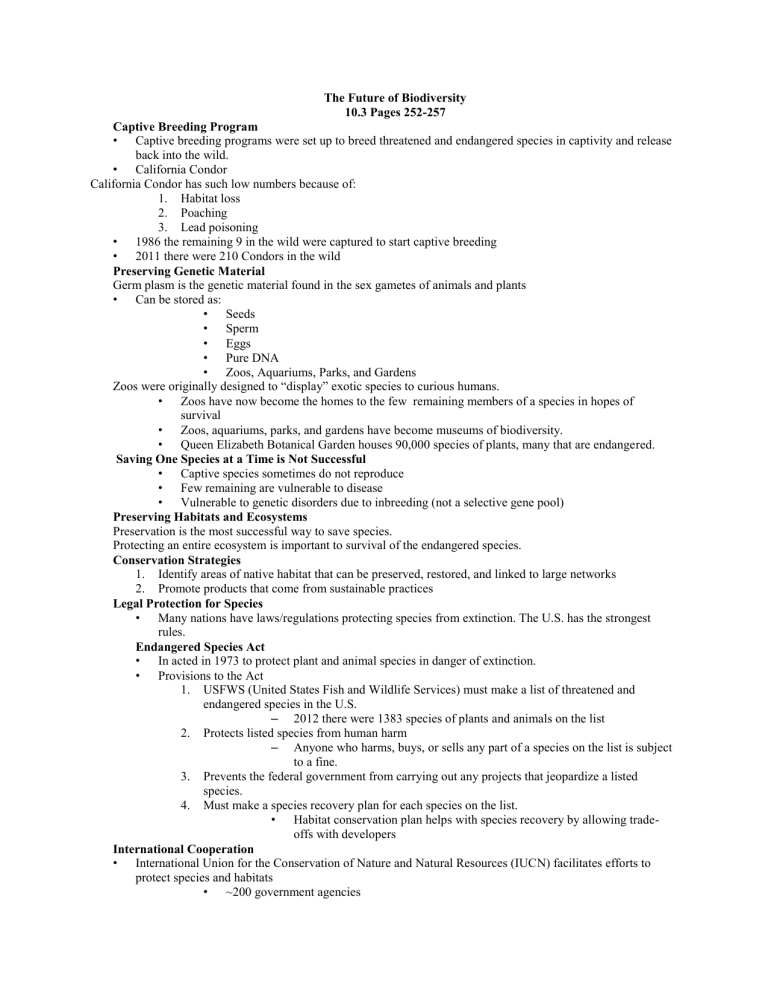
The Future of Biodiversity
10.3 Pages 252-257
Captive Breeding Program
• Captive breeding programs were set up to breed threatened and endangered species in captivity and release back into the wild.
•
California Condor
California Condor has such low numbers because of:
1.
Habitat loss
2.
Poaching
3.
Lead poisoning
• 1986 the remaining 9 in the wild were captured to start captive breeding
• 2011 there were 210 Condors in the wild
Preserving Genetic Material
Germ plasm is the genetic material found in the sex gametes of animals and plants
• Can be stored as:
•
Seeds
• Sperm
• Eggs
•
Pure DNA
• Zoos, Aquariums, Parks, and Gardens
Zoos were originally designed to “display” exotic species to curious humans.
• Zoos have now become the homes to the few remaining members of a species in hopes of survival
• Zoos, aquariums, parks, and gardens have become museums of biodiversity.
• Queen Elizabeth Botanical Garden houses 90,000 species of plants, many that are endangered.
Saving One Species at a Time is Not Successful
• Captive species sometimes do not reproduce
• Few remaining are vulnerable to disease
•
Vulnerable to genetic disorders due to inbreeding (not a selective gene pool)
Preserving Habitats and Ecosystems
Preservation is the most successful way to save species.
Protecting an entire ecosystem is important to survival of the endangered species.
Conservation Strategies
1.
Identify areas of native habitat that can be preserved, restored, and linked to large networks
2.
Promote products that come from sustainable practices
Legal Protection for Species
•
Many nations have laws/regulations protecting species from extinction. The U.S. has the strongest rules.
Endangered Species Act
• In acted in 1973 to protect plant and animal species in danger of extinction.
•
Provisions to the Act
1.
USFWS (United States Fish and Wildlife Services) must make a list of threatened and endangered species in the U.S.
– 2012 there were 1383 species of plants and animals on the list
2.
Protects listed species from human harm
– Anyone who harms, buys, or sells any part of a species on the list is subject to a fine.
3.
Prevents the federal government from carrying out any projects that jeopardize a listed species.
4.
Must make a species recovery plan for each species on the list.
• Habitat conservation plan helps with species recovery by allowing tradeoffs with developers
International Cooperation
• International Union for the Conservation of Nature and Natural Resources (IUCN) facilitates efforts to protect species and habitats
• ~200 government agencies
• Over 700 private conservation groups
•
Create Red Lists for endangered animals/plants world wide
• Works with the WWF (World Wildlife Fund) to sponsor projects
•
International Trade and Poaching
CITES (Convention on International Trade in Endangered Species)
– 1 st effective group effort to stop slaughter of African elephants for ivory
– Elephant poaching has dropped significantly with the world wide ban of ivory sells
The Biodiversity Treaty
• Most ambitious effort-Earth Summit
• 100 world leaders and 30,000 participants in 1992
• Goal to preserve biodiversity and ensure the sustainable fair use of genetic resources.
•
U.S. political groups objected to the Treaty because the Treaty suggested that economic and trade agreements should be taken into account if there were impacts on biodiversity
Private Conservation Efforts
•
Nonprofit organizations work to protect species worldwide
– WWF-encourages sustainable use
– Nature Conservancy-buys habitat to protect that area
–
Conservation International-helps identify hotspots and develops ecosystem conservation projects
– Greenpeace International- direct and confrontational actions to counter environmental attacks
